All plants living in pots and containers require periodic repotting. Learn how to repot a plant properly in this post. Read our essential tips and watch our videos for all the details. Protect your plants as you repot. And Make the correct choices for a long lived, healthy, thriving plant.
Learn how to Repot plants into appropriate pots and fresh soil that gives your plants the best chance for happiness. Repotting offers roots fresh nutrients, good drainage, better oxygenation, and more room to grow. Happy roots make a happy plant.
Repot a plant properly and it will continue to add green beauty to your home year after year. Watch our videos further down this post to see Kayti demonstrate how to repot plants.
Repotting correctly helps plants give you their best colors, leaf size and robust growth from the roots up to the tips of their leaves.
What is the Meaning of Repotting Plants?
Repotting plants means you remove a plant from the pot it is growing in and replant it into a new pot. This is a time to give your plant a larger, well drained pot with fresh soil to keep it thriving and healthy or address problems with the plant.
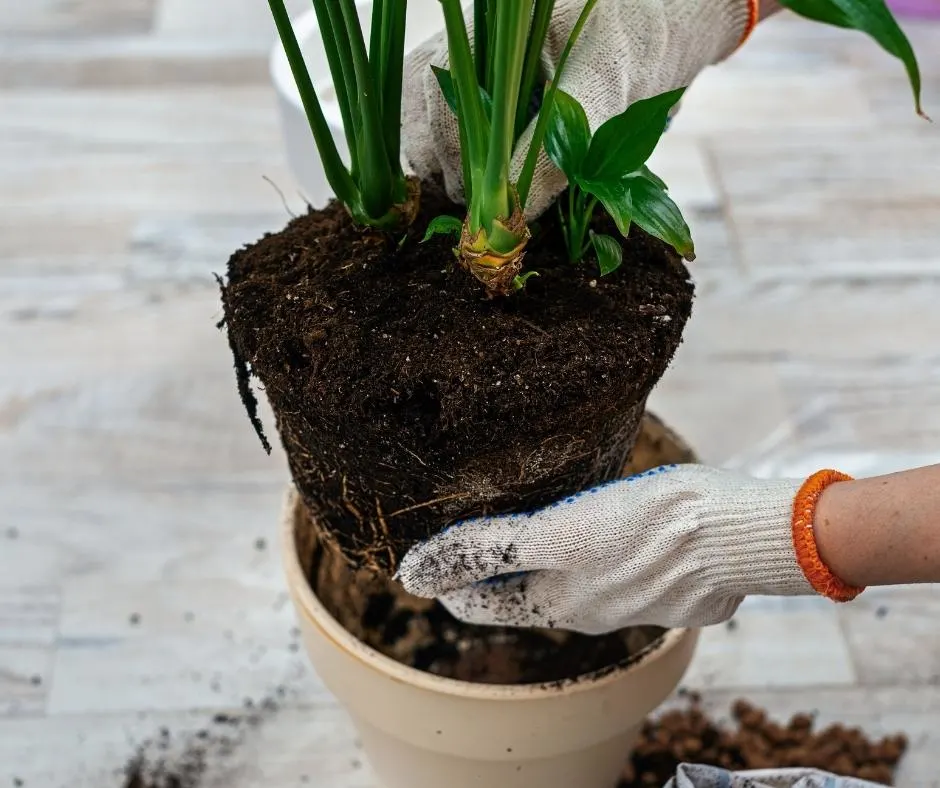
When Does A Plant Need Repotting?
A Plant needs repotting when it has outgrown its pot and/or the soil is exhausted. Look for signs of plant stress. A stressed , constantly dry or stunted plant probably needs a repot. As a rule of thumb, plan to repot your plants every year or two.
Indoor plants, potted kitchen herbs and patio container plants reside in pots permanently. The plant feeds itself from the soil in the pot. Eventually the soil degrades and the pot becomes too small as the plant grows.
Even healthy thriving potted plants should be evaluated annually to see if they need repotting.
Your plant may need repotting IF…
- Your plant has outgrown its pot. Are roots coming out the drainage hole? Some plant enjoy a certain amount of root bind. However, if the plant is constantly dry with hydrophobic soil or growing small leaves, it is time for a repot.
- Have you Found a pretty pot that is just right for your home? The plant may be happy and not need a repot but will likely survive, and even thrive if repotted correctly. OR you could set the existing plant pot in a cover pot and avoid repotting a happy plant..
- The plant needs support. It’s time to install a moss pole . This is a good time to repot the plant into a larger pot and properly anchor the pole.
- It’s time to replace old soil. All pots and containers require soil refreshment after a year or so. Depleted, compacted soils cannot feed or provide water correctly to your plants.
- Plant Propagation is due.Your mother plant may be growing babies as offsets and need dividing and repotting. Watch our video further down in this post on plant propagation for more on that.
- You’re Rescuing a sickly plant. Repotting may or may not help the plant. Diagnose the plant problem and then decide if repotting is the best step forward. Sick unhealthy roots and how to fix root rot are discussed in depth in this post. If you don’t treat root rot, repotting will not save your plant. Watch me REHAB A PEACE LILY in this video.
- The soil is molding or infested with soil pests like fungus gnats. However, We have other solutions and information about both moldy soils and fungus gnats without repotting. But constantly saturated soils might need to be replaced to solve these problems.
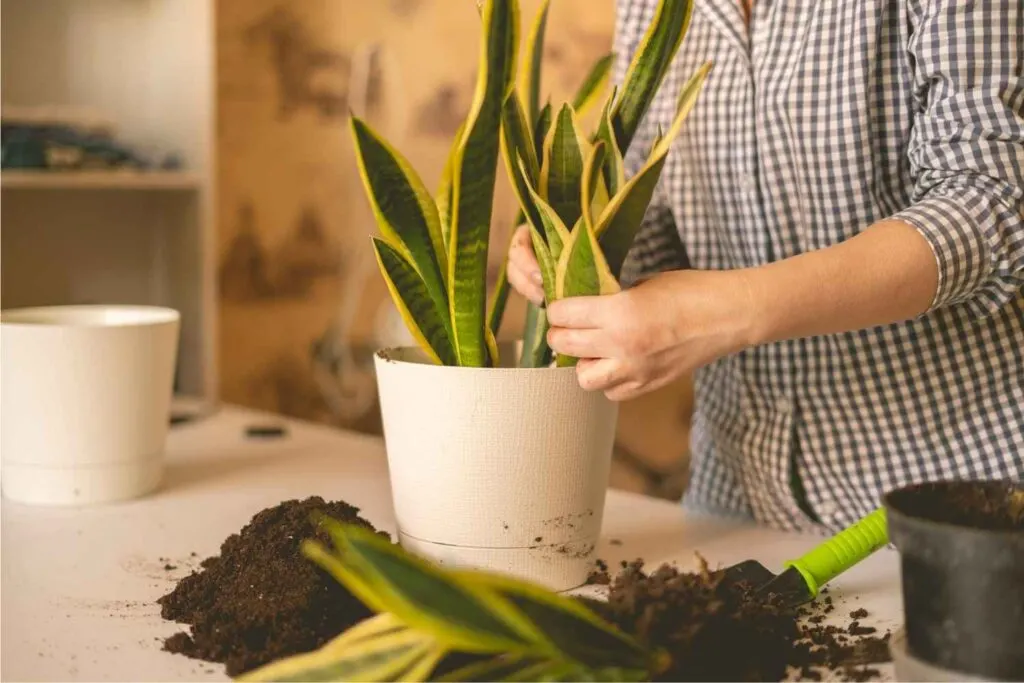
When is the Best Time to Repot a Plant?
You can repot a houseplant any time of the year if needed to save a sick or dying plant. Yet, For best results repot healthy plants in early spring when the plants come out of winter hibernation.
In the growing season new shoots and leaves emerge. New growth is beginning below the soil too. Roots grow and expand into the soil to find nutrients to support new growth. Fresh, nutrient rich soil and a larger pot are welcome to feeding roots in early spring.
Can you repot a plant in winter? You can repot a plant in winter if you absolutely need to. However Some plants are sensitive and may respond badly. Since Winter is a time of dormancy for plants it is not the BEST time to do a repot.
How To Repot A Houseplant:
Watch the video above on How to repot a Plant. Kayti demonstrates the whole process and discusses repotting in depth.
Supplies Needed to Repot A Plant:
- Work surface (this is a messy process)
- Garbage bag, sheet of plastic, or other receptacle for old soil
- Plant in need of repotting
- Appropriate pot or containers
- bleach (to clean and reuse tools and old pots)
- proper soil
- Support stakes or moss pole as needed.
- Velcro tape as needed.
- soil amenities (as needed)
- Scooping tool
- Mixing tray, bucket or bowl to make plant soil mix.
- Knife (to release plant from pot sides if necessary)
- Sharp sterile scissors (for pruning off dead or diseased roots and leaves as needed, lightly shaping roots to pot shape and cutting soil bags etc.)
- Gloves (To protect from sap of toxic plants like aroids and poky plants like asparagus fern) and always for clean hands.
- water for washing and watering the soil.
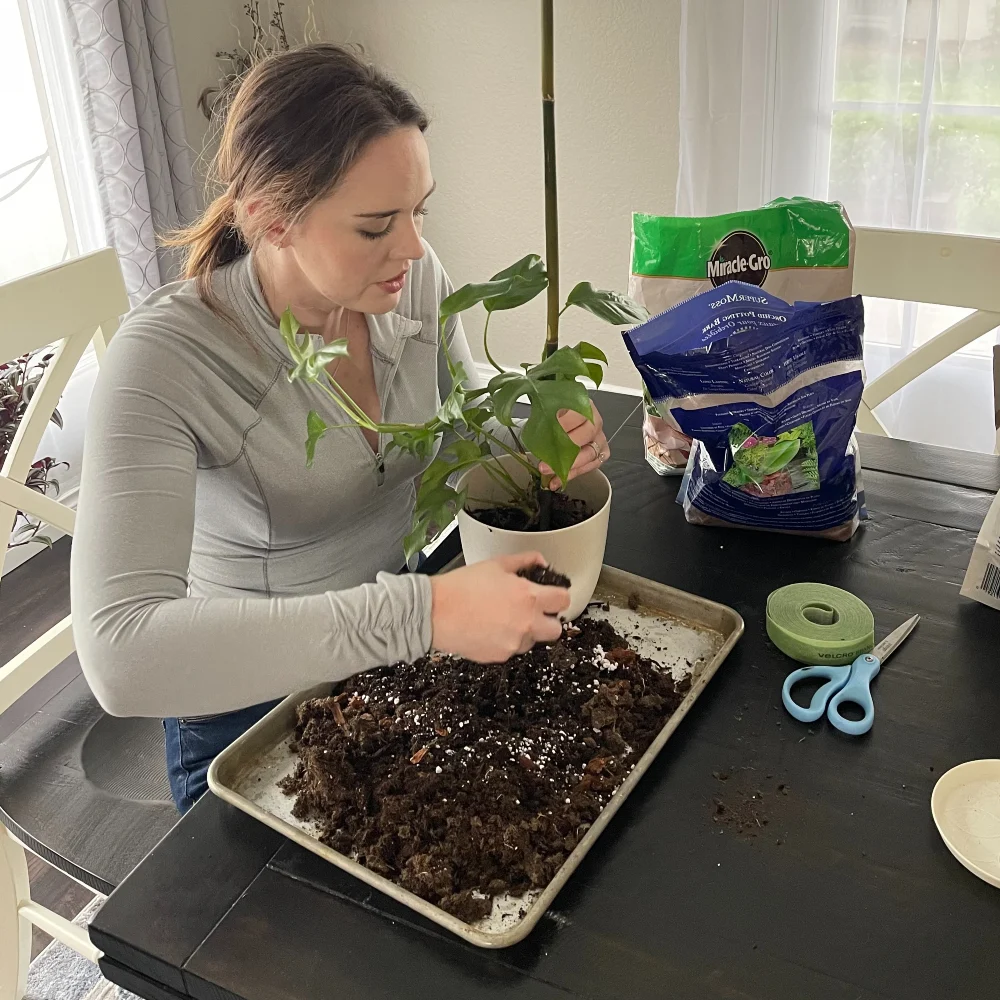
How do you do repotting?
Once you determine your plant will benefit from repotting the process is pretty simple, if somewhat messy.
- Prepare your work area.
- Pick a well drained pot that fits the plant roots.
- Choose or make a good soil mix for your plant.
- Unpot the plant from the old pot and inspect it. Correct any problems or disease the plant or roots have before repotting.
- Put drain rock in the bottom of the new pot as desired for better drainage or to fill a pot that is too deep.
- Place new soil mix in a layer over the drain rock about one third up the pot.
- Gently place the prepared plant into the fresh soil mix.
- Arrange more potting soil around the roots. Be sure to fill in the root area well and leave no large air gaps.
- Fill the pot to the soil line on your plant. Some plants like the crown of the plant covered and others do not. KNOW your plant.
- Water the soil and press the plant gently into the pot to anchor it and eliminate large air pockets.
- Add more soil as necessary to fill the pot as needed.
- clean up the mess.
We cover all the details of repotting plants in this section below.
The Best Pot for Your Plant:
We want pots that look good as part of our home decor. It’s tempting to choose a pot based on color or material or adorable styling.
Getting a cute set of pots for a plant collection like orchids or African violets, can show them off and create a wonderful visual in your home.
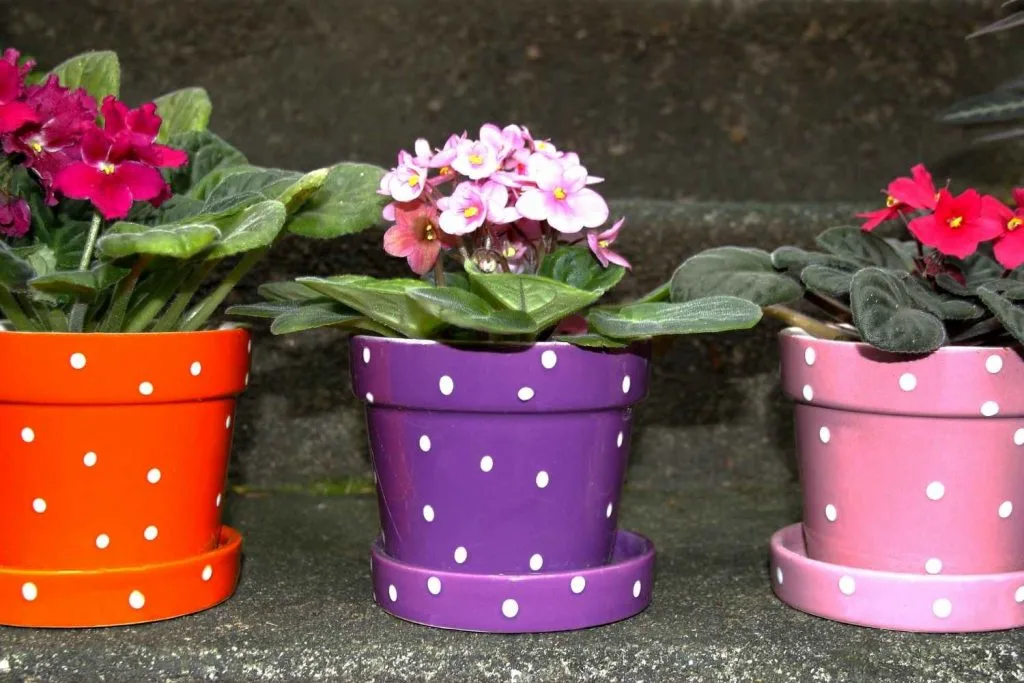
But the container your plant lives in is critical to maintaining a healthy plant. Aside from adding decor to your home plant pots must offer the plant what it needs for healthy growth.
Good drainage is essential for plant health. Water and excess salts from watering and fertilizing MUST be allowed to drain off. Soils concentrate salts. Over time the salt content of the soil becomes toxic to the plant. Also, water logged soil that cannot drain is the number one killer of houseplants. Excess water in soil sits around plant roots too long causes root rot.
Drainage: Choosing a pot without drainage is extremely dangerous for plant health. Water will be trapped in the soil. Soggy, saturated soils that rot roots are the biggest problem for plant health.
What is good drainage? All most pots offer is one drainage hole in the bottom of the pot. This is adequate for most plants. The excess moisture can escape through the bottom of the pot and allow roots to breathe.
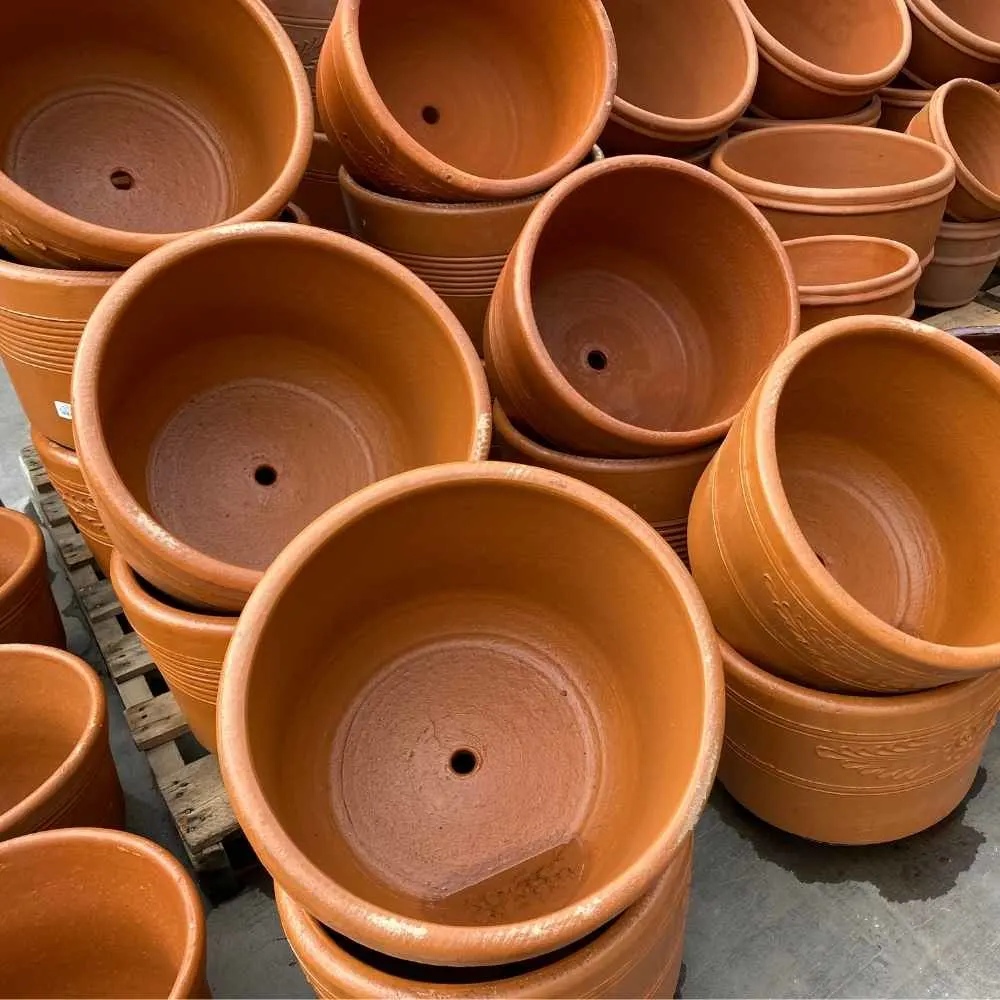
POT SIZE: Like drainage, choosing the correct pot size when repotting your plant is critical. A pot that is too large will hold way too much water around plant roots for too long. Root rot will result.
The pot must fit the root ball. A pot an inch or so larger in diameter from the old pot will accommodate 2 years growth for most plants.
A tall or wide bush or small tree, like the money tree, can fool you into thinking a large pot is required.
Do NOT look at the foliage size. Look at the root ball. It needs enough container space to grow an inch or so a year for a couple of years. Then you can switch it to a new larger pot that better fits the growing plant and roots system.
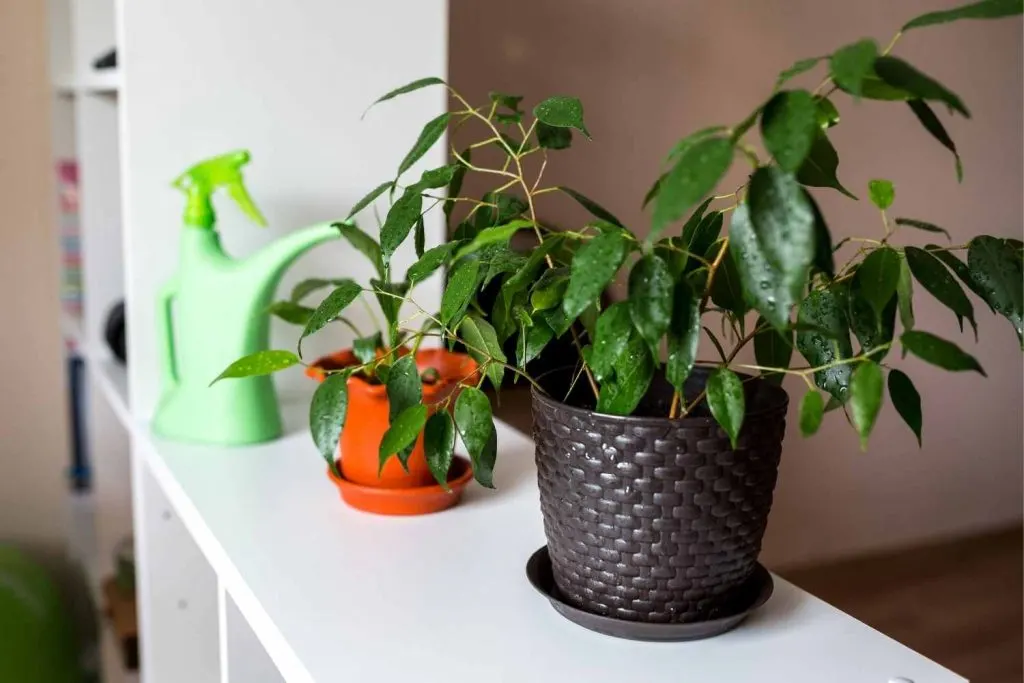
Pot Depth: Again, too deep a pot will hold water in the soil too long. Even a well drained pot will hold waterlogged soil too long around the roots if there is too much soil in the pot. This leads to root rot. If you want to use a deep pot fill the bottom with good drainage rock or LECA clay balls.
Using too large a pot either in diameter or depth, will lead to over saturated soil that will rot the plant roots. Look for a pot about 2 inches larger around than your old pot and about the same depth. or just enough deeper to allow roots to grow.
Materials: Pot materials are commonly Plastic, terra cotta or glazed porcelain pots. Does it matter which you choose? It’s all about the plant you are tending. What do their roots need?
Most tropical plants will grow fine in a well drained plastic nursery pot. Plastic pots are cheap and last forever. Just be sure the soil is very light friable and porous since these pots don’t breathe.
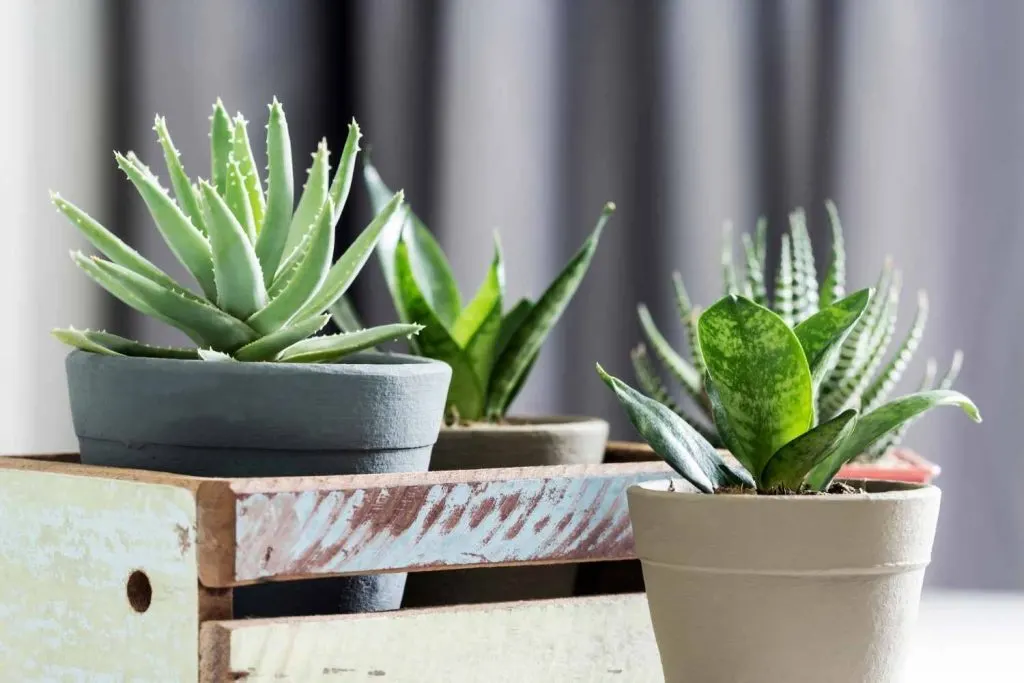
Cactus and Succulents like to dry out between waterings. For them and most plants that like drier soil, terra cotta is an excellent pot material. Read our post on watering succulents here.
Most plants grow well in porcelain pots if the soil is correct for the plant. It is best if the interior of the pot is glazed as well as the outside. Plant roots are strong. They may eventually grow into the inside of the pot ( I have had this happen) and dissolve the pot.
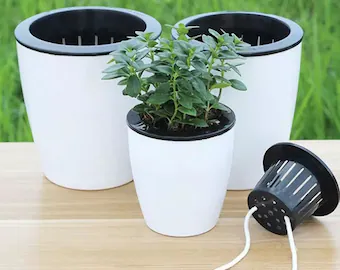
Self watering plant pots: These pots are usually a two part plastic pot. They have a reservoir designed so the plant will suck up only what it needs from the bottom of the pot. We use these pots in LECA systems and also for soil planted plants. Orchids, do well in net pots with self watering systems.
Self watering pots are especially helpful if you tend to over water your plants. Plants can take care of themselves in a self watering pot. All you have to do is make sure the water is in the reservoir.
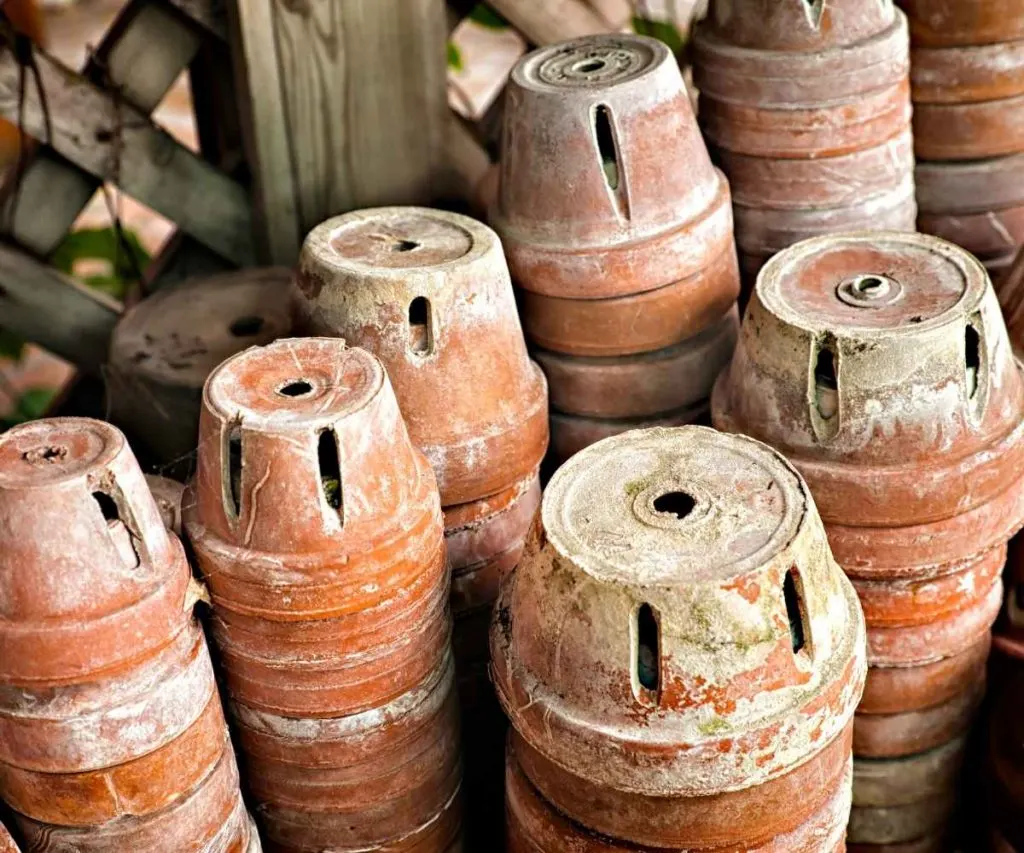
Reusing Pots:
Can You Reuse Old Pots for repotting? Yes you can. But you must clean and bleach old pots to sanitize them. Dirty pots can spread pathogens and pests to your plants when you repot.
Cover or Cache Pots:
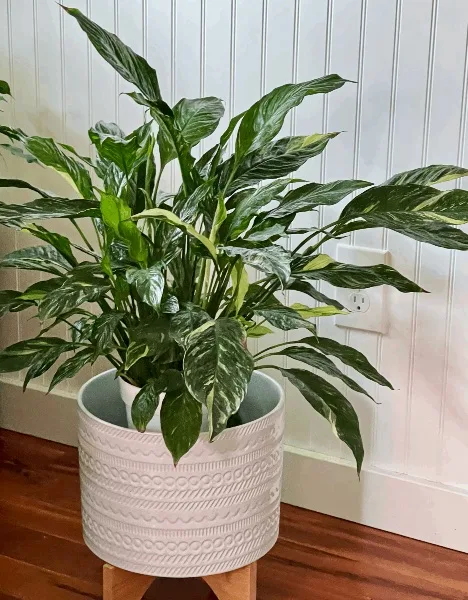
IF you find a pot that is JUST the perfect pot and you must have it but it has no drainage, make it a cache pot or cover pot.
To use a non draining decorative pot choose a cover pot that is slightly larger than your repotted plant and place your draining pot into it. Drain rock, lava rocks or volcanic rock can be added to the bottom of the cover pot if you need more height and to catch puddling water.
This way, Decorative pots with no drainage holes can be used to an hide ugly plastic container or terra cotta pots. if you place a well drained pot INSIDE the cover pots the plant will enjoy good health and look great in your home.
Choosing the Proper Soil:
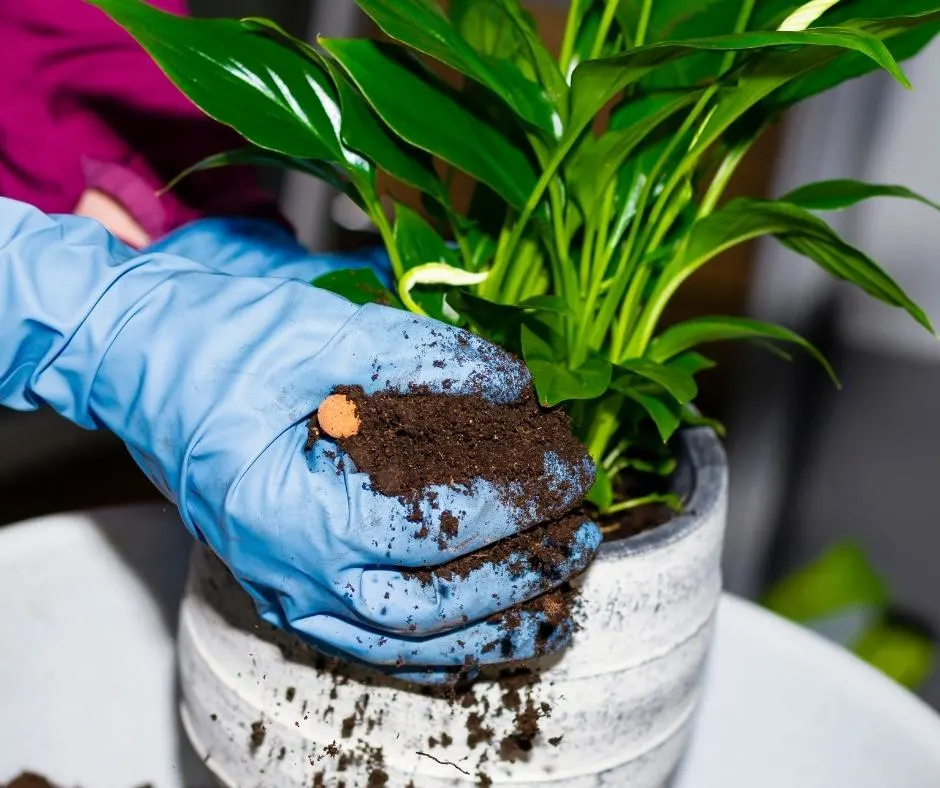
Choosing the correct potting soil or substrate for your plant is critical for your plant. Soil is the most popular substrate for plants.
LECA is another substrate you may wish to explore. We have a complete series on LECA pros and cons and how to use it. Start here for more on LECA.
For this post we will stick with soil as the substrate.
Can Store Bought Potting Mix Work by Itself?
Store bought potting mix works best when mixed with organic and inorganic amendments as your plant requires. Most potting mixes will compress and hold too much moisture around the roots of potted plants when used alone.
When you repot, new fresh potting soil offers the very best nutrients and texture to support the plant once it is properly mixed with in-organics. Many house plants require inorganic additions to potting soils. Pothos, monsteras, philodendrons, peace lilies require light friable well drained soil that is properly amended with perlite.
Most purchased potting soils will need amendments to fit your individual plants needs best. Perlite, lava rock, volcanic pumice and other chunky inorganic materials are usually mixed in to give added drainage and structure as a plant requires.
Making Your Own Soil Mix:
Mixing your own soil mix is very easy and gives you the very best mix for each plant. Just follow the soil recipe in the care guide for the plants you are repotting.
Which type of soil best suits your plant? Search this blog. Our care guides tell you how to mix a proper soil for every plant in our care guides.
Succulents are especially sensitive to the soil they are planted in. However, You can buy cactus and succulent soil that is pretty close to perfect. Only a few extras or none at all will be needed for these plants.
Read Best Succulent soil mix, and our in depth post on Snake Plant soil mix so you can make the soil in just the right blend for their dry loving roots.
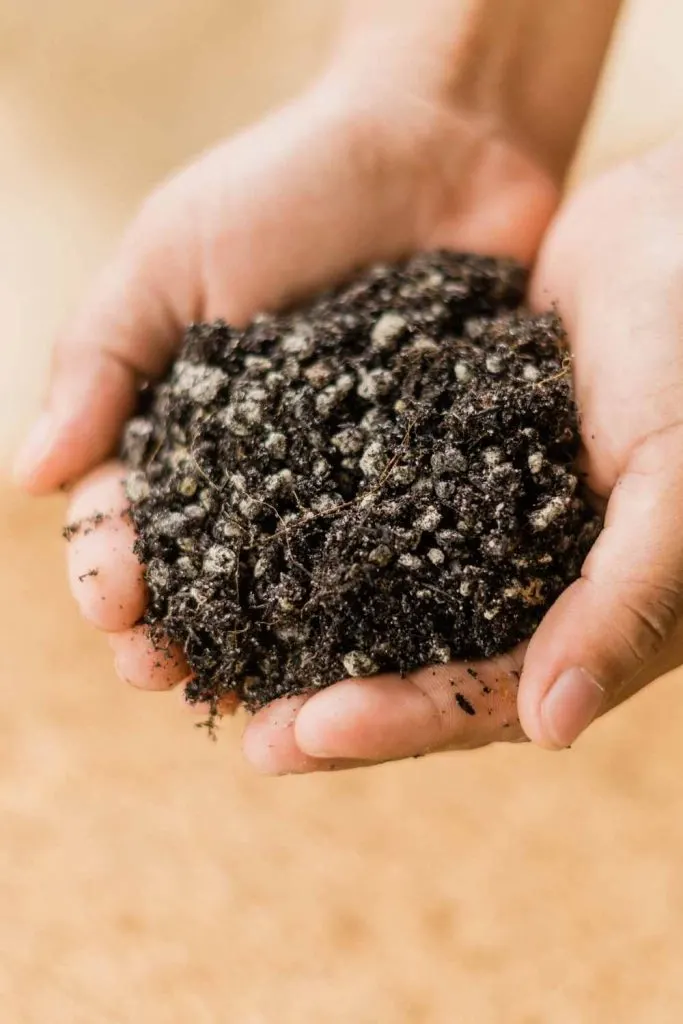
How To Sterilize Old Potting Soil For Reuse:
Can you reuse old potting soil? Yes. However, used potting soil (or garden soil) is somewhat depleted and full of pathogens and sometimes pests.
Old potting mix can be saved and reused to pot another plant but you MUST sterilize it first.
To Sterilize Soil: Spread out the potting soil (or garden soil) on a baking sheet or in a large casserole dish and bake it at 200 degrees F. for about an hour. To be thorough, remove the pan at 30 minutes and mix the soil around to make sure it is evenly heated. Allow the soil to cool before reusing it. This process will sterilize the soil.
Old sterile potting soil needs to be blended with good quality organic amendments like sphagnum moss or coir to enhance the soil texture. Don’t use more than 50% old soil in with new soil so the plant gets adequate nutrients, or expect to fertilize religiously.
Garden soils are NOT recommended for indoor plants unless you are able to sterilize the soil and ensure there are no toxins to the plant in the soil. Also know what ph and minerals are in the soil. Are they beneficial to your plant? Use only about 25% sterile garden soil in with a fresh potting mix to best support your plants.
Adding a Moss Pole While Doing A Plant Repot:
For tall plants and vines (show video) sometimes we repot to anchor in a supporting rod or Moss pole so the plant can grow up the support.
Adding a moss pole is easiest when we repot. Here’s a video and post on how to do that.
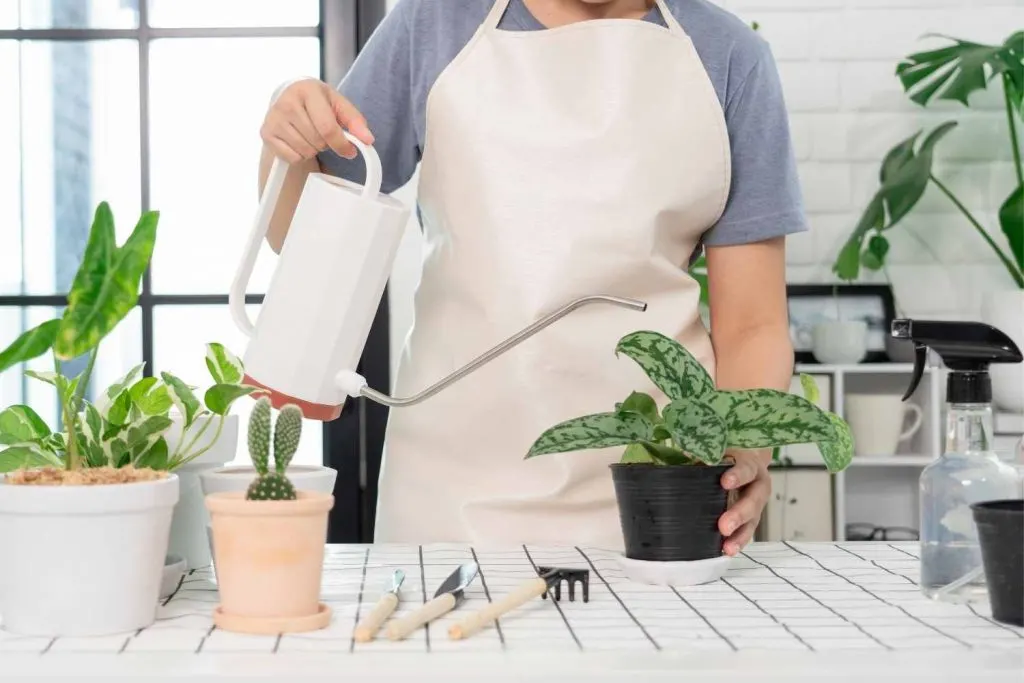
Should you Always Water After Repotting?
You should always water after repotting. For best results, water the newly repotted plant and allow the water to completely drain out the pot. Pour any water left in the drain plate out.
Gently press the plant at the soil line into the moist soil to firmly seat it in the soil. Watering after repotting will compress the new soil around the plant roots and eliminate large air pockets that cause roots to dry out.
Final Touches After Completing Your Repot:
Repotting is messy work. After repotting dirt may cling to the plant leaves, plant pot and for sure your work surface.
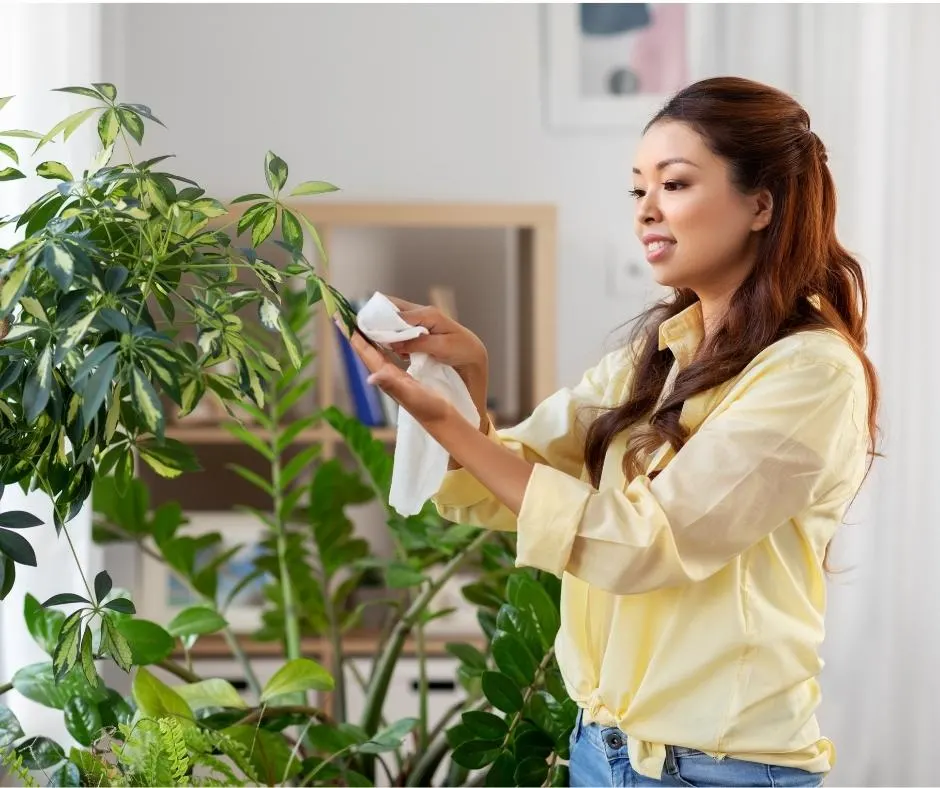
What other set up do you need to prepare before placing you repotted plant? Here are some ideas for final touches to consider before placing your plant.
- While the plant is still fresh in the pot on the work area is the best time to adjust it. Sometimes the plant may not sit in the pot as you like. Just gently lift the plant a little (no need to pull it completely out of the pot) and rearrange it gently so you don’t break any roots. Now press the soil back around the adjusted plant.
- This is a great time to clean the leaves of your plant. Neem oil mixed with water will add a pretty shine to the leaves and help repel insects.
- Wipe down the outside of your pot including the bottom so its free of soil.
- Consider the best lighting for your potted plant. Do you need artificial lights? Add them now.
- To add extra humidity for tropical foliage set up pebble trays. Place the pebble tray where you want the plant to live. Add water to the pebble tray but be SURE the plant cannot suck up that water. The plant leaves will absorb the water as it evaporates from the tray and hydrate the plant.
- If you want a bottom watering system set the pot into a tray at least two inches deep. Water into the tray as needed rather than watering into the soil top. This system has many advantages. We go in-depth on The bottom watering method here.
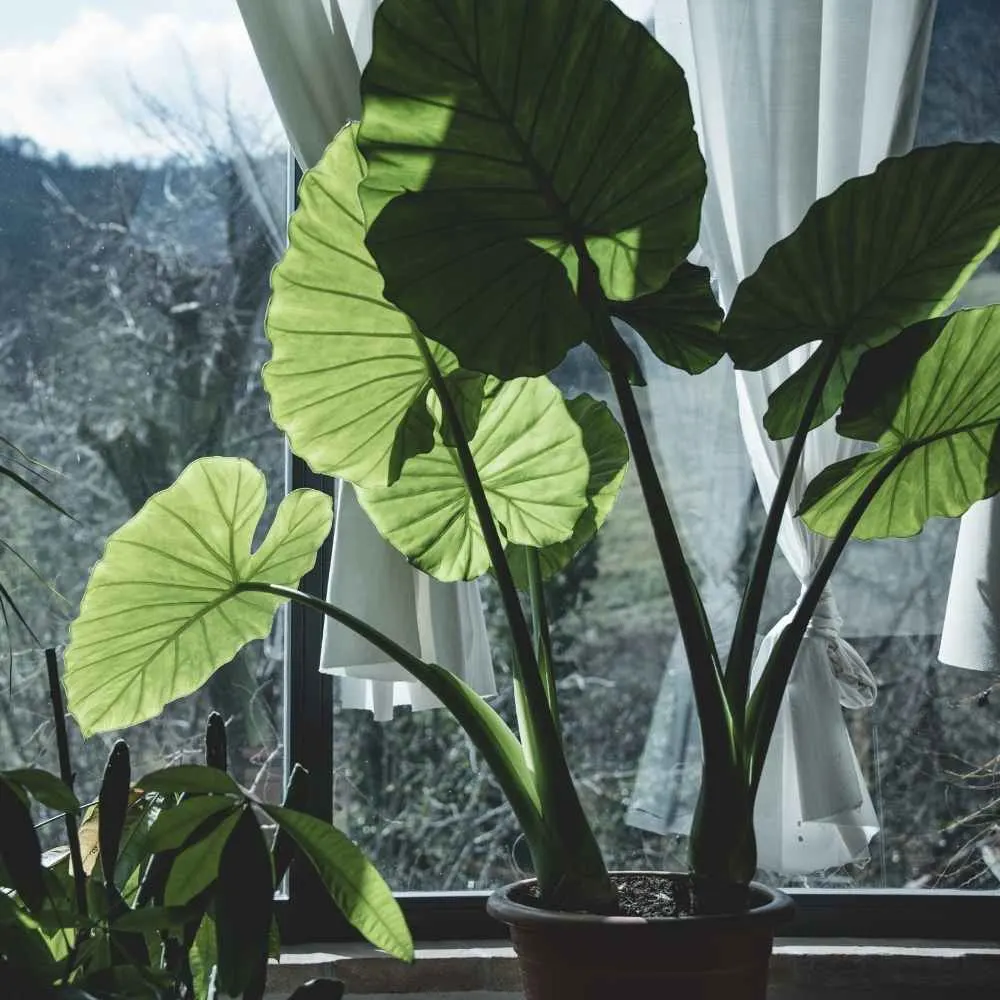
Why Are My Plants Dying After Repotting?
Repotting a plant is stressful. Even healthy plants may droop for a day or two after repotting. If you are repotting a sick plant in hope of rehabbing it; it may take several weeks to see signs if it is actually reviving.
Plants that begin to decline after repotting and do not rebound in the first week need attention. Either something went wrong in the repotting process, they are dormant, or sick, or you injured the plant in the repot process. It happens.
Your plant may be dying (or not doing well) after repotting because…
- There may be air pockets around the roots or in the root ball itself. This will dry out the roots and cause them to die. In this case, you will see a section of the plant die. Eventually the dead roots will spread contagion to the other plant roots until the whole plant is dying. You may need to unpot the plant and examine the roots. Look for root rot and air gaps.
- It was too sick or fragile to repot. A plant with rotted roots may not be able to be saved with a repot. Learn how to fix root rot in this post.
- if the plant was heavily infested with pests prior to repotting; new soil and a new pot is not going to fix that. Learn more about the seven most common plant pests and how to control them in this post.
- If you repotted in winter the plant was hibernating. Repotting in the dormant season is harder on plants. It may revive come spring. Reduce watering until new growth appears.
- You potted with the wrong soil (or a toxic soil if you used garden dirt) for the plant.
- Check the light. Be sure your plant has the correct lighting. More on that in this post.
- Bad watering practices will always lead to plant death eventually. Learn more about good watering practices here. Likewise, Some plants, like Calatheas, are very sensitive to the types of water you use. Your ph may be wrong or too many minerals in the water.
- be gentle during the unpotting and repotting process. Roots and leaves can be damaged during repotting.
If you see a problem after repotting check all the things we have listed here and the detailed plant care guides to see if you can puzzle out what is going on. Hopefully your plant will come about once the problem is corrected. Best of luck!
All plants require occasional repotting. We hope this post gives you all the information you need to make your plant repot a success. If you have further questions please ask them in the comment section below.
Watch ALL our videos on repotting and other houseplant topics HERE on YouTube:
Follow Us:
Find us on YouTube, Instagram , Pinterest and TikTok! We love to Plant chat. We also comment, like and occasionally share your content to our daily stories. We’d love to see your plants. Share your joy in your houseplants. Happy Planting!
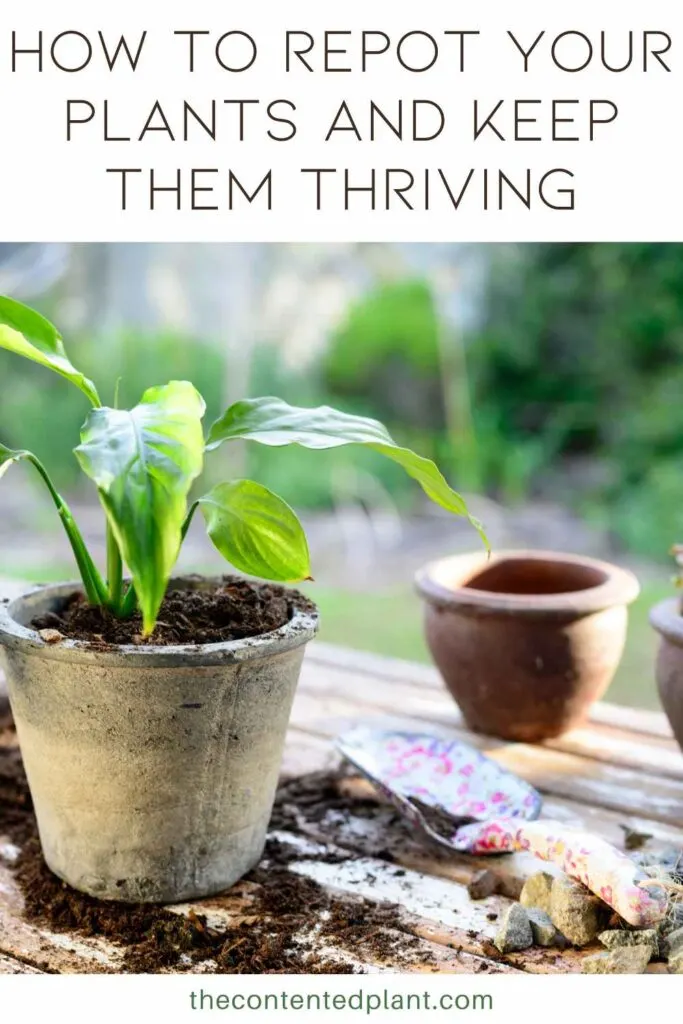

Kimberly Queen Fern Care Guide - The Contented Plant
Tuesday 30th of January 2024
[…] growing season is the best time for planting outdoors or repotting […]